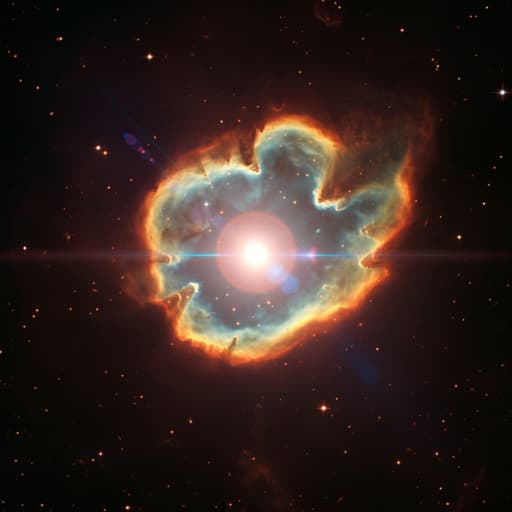
Physics
Indirect Detection of Decaying Dark Matter with High Angular Resolution: Case for axion search by IRCS at Subaru Telescope
W. Yin and K. Hayashi
This groundbreaking research by Wen Yin and Kohei Hayashi delves into cosmic-ray flux from dark matter decay in dwarf spheroidal galaxies, presenting innovative differential D-factors to enhance signal detection. The study highlights the potential of the Infrared Camera and Spectrograph at the Subaru telescope to revolutionize dark matter detection, particularly for axion-like particles, suggesting that key observations could surpass existing stellar cooling bounds!
~3 min • Beginner • English
Introduction
The study addresses how to optimize indirect searches for decaying dark matter (DM) in dwarf spheroidal galaxies using detectors with small fields of view and/or high angular resolution. Within the ΛCDM cosmological framework, DM is abundant and centrally concentrated in galaxies, but its non-gravitational properties remain unknown. Traditional direct detection and indirect searches have excluded large portions of parameter space for DM above keV–GeV masses. Recently, attention has turned to light DM (eV–keV), leveraging spectrographs with arcsecond-level angular resolution and high spectral resolution that enable line searches from two-body DM decays. The research question is whether using the differential D-factor (line-of-sight integral of the DM density per solid angle) rather than the conventional integrated/averaged D-factor can significantly enhance signal predictions and sensitivity for such instruments. The purpose is to compute and apply differential D-factors for many dSphs, quantify signal enhancements and uncertainties, and propose an observational strategy with Subaru/IRCS to probe eV-mass axion-like particles (ALPs). The importance lies in better matching detector capabilities to DM distributions, potentially enabling discovery-level sensitivity beyond stellar cooling bounds in the 1–2 eV mass range.
Literature Review
The paper builds on prior indirect searches for light DM using optical/IR spectrographs. Constraints on ALP DM in the 2.7–5.3 eV range have been derived from MUSE observations of Leo T, and in the 4.5–7.7 eV range from VIMOS observations of Abell clusters, demonstrating the power of arcsecond angular resolution. More recently, high-resolution IR spectrographs (e.g., WINERED on Magellan Clay; JWST/NIRSpec) were highlighted for their ability to suppress sky background via extreme spectral resolution, enabling searches for line-like signals from two-body DM decays. Conventional analyses often use integrated/averaged D-factors over large apertures, which suit wide-field or lower-resolution instruments. However, for small-FOV, high-resolution instruments, sensitivity to the spatial DM distribution motivates the use of a differential D-factor. Mass modeling literature using Jeans analysis and other techniques has shown degeneracies between DM density and stellar velocity anisotropy; recent non-spherical, axisymmetric Jeans models mitigate this degeneracy by fitting two-dimensional velocity dispersion fields, improving constraints on central DM densities relevant for line-of-sight integrals.
Methodology
- Signal model: Consider decaying DM ϕ with rest mass mϕ and decay width Γϕ producing photons. The observed photon flux is separated into extragalactic (isotropic, continuous) and local (from a target halo) components; the study focuses on the latter for dSphs.
- For a given target i, the differential photon flux per energy and solid angle is proportional to Γϕ/mϕ times the line-of-sight integral of the DM density multiplied by the photon spectrum from a single decay. For two-body decays ϕ → γγ, the rest-frame spectrum is a line at Eγ = mϕ/2. Doppler broadening from dSph velocity dispersions (<10 km/s) is negligible compared to spectrograph resolution R ~ 10^4, so the line is effectively unresolved apart from the systemic radial velocity shift.
- Differential D-factor: Define ∂ΩD(Ω) = ∫ ds ρϕ(s, Ω), the line-of-sight integral of the DM density per solid angle. Then the signal flux factorizes: d^2Φγ/(dEγ dΩ) ≈ (Γϕ/4π mϕ) ∂ΩD(Ω) Frest[Eγ/(1 − v_rel)], where v_rel is the target’s radial velocity. This quantity is independent of particle physics (given single-component cold DM) and captures spatial dependence crucial for small-FOV/high-resolution instruments. An optimized, detector-weighted D-factor is defined as D_optimized(E) = ∫ dΩ P_det(Ω, E) ∂ΩD(Ω), allowing inclusion of throughput, masks, and spatial weighting.
- DM halo modeling: Compute ∂ΩD for many dSphs using mass density profiles from non-spherical, axisymmetric Jeans analyses (Hayashi et al. 2020, 2022), adopting Hernquist profiles (with comparisons in the literature to NFW/Einasto/Burkert). Axisymmetric models mitigate degeneracies between DM density and stellar velocity anisotropy by fitting 2D line-of-sight velocity dispersion maps, yielding more robust central density estimates. Uncertainties are dominated by the halo shape–anisotropy degeneracy and, for ultra-faint dwarfs, small kinematic samples.
- Star crowding and masking: Estimate typical angular separation between visible stars from stellar number density Σ_N via d_stars ≈ Σ_N^{-1/2}, using King-model fits and published star counts for many dSphs. Compare with instrument slit size to plan masks and avoid bright stars, critical for small-FOV observations.
- Instrument and observational setup (Subaru/IRCS): Target Draco and Ursa Major II. Use high-resolution IR spectroscopy (bands zJ, J, H, K, L, M; R ~ 10^4–2×10^4) to search for the narrow decay line. Treat two primary backgrounds: (i) diffuse sky (e.g., zodiacal light) modeled via IPAC/IRSA; choose observing windows where high spectral resolution suppresses background sufficiently; (ii) starlight within the FOV, mitigated by masking/slit placement given sparse central stellar densities and small slit dimensions (~0.1″ × 1″). Sensitivities per band (mag/arcsec^2) for 8-hour exposures are taken from the IRCS exposure time calculator.
- Sensitivity estimation: Combine ∂ΩD at the central regions of the targets, instrumental sensitivity, and exposure time to derive reach in ALP parameter space (g_{ϕγγ} vs mϕ), accounting for ∂ΩD uncertainties from halo modeling. Compare to stellar-cooling bounds and theoretical benchmarks (QCD axion hadronic window; ALP miracle).
Key Findings
- Differential D-factor enhancement: Using ∂ΩD at the central arcsecond scales yields an O(1–10) enhancement in expected signal flux relative to conventional analyses that average D over large apertures, with a different and often reduced theoretical uncertainty relevant to the observed region.
- Draco: log10(∂ΩD / [GeV cm^-2 sr^-1]) = 22.60 (+0.27, −0.26) at r ~ arcsec from center. Naive average over ∆Ω = (0.5°)^2 π gives log10(D/∆Ω) ≈ 21.07 (+0.20, −0.16).
- Ursa Major II: log10(∂ΩD / [GeV cm^-2 sr^-1]) = 22.50 (+1.02, −0.52) at r ~ arcsec. Naive average over the same ∆Ω gives log10(D/∆Ω) ≈ 21.45 (+0.38, −0.48).
- Observational feasibility with Subaru/IRCS: Central stellar densities in Draco and Ursa Major II are sufficiently sparse (typical separations O(10″–100″)) to avoid stars with the IRCS slit size (~0.1″×1″). High-resolution spectroscopy suppresses diffuse backgrounds; appropriate scheduling reduces zodiacal light.
- Sensitivity: With O(1) hours to a few nights of observation, IRCS can probe ALP dark matter in the 1–2 eV mass range and surpass horizontal-branch stellar cooling bounds (g_{ϕγγ} ≲ 4.7×10^-11 GeV^-1) for ϕ → γγ decays, enabled by the ∂ΩD-based flux enhancement. Eight-hour sensitivities per band (mag/arcsec^2) from IRCS ETC: zJ 21.8, J 21.6, H 21.3, K 20.8 (R≈20000), L 16.3, M 14.7 (R≈10000).
Discussion
The findings demonstrate that for small-FOV and high-angular/spectral-resolution instruments, the spatial non-uniformity of DM within dSphs must be explicitly incorporated via the differential D-factor. This approach concentrates on the central, high-density regions and aligns the theoretical prediction with the actual observed solid angle, reducing contamination from outer halo regions that dominate conventional averaged D-factors. The resulting enhancement in expected signal flux and the different uncertainty budget directly improve sensitivity to decaying DM models, particularly two-body decays producing narrow lines. The study also outlines how the angular morphology of a putative signal can be cross-correlated with ∂ΩD(Ω) to discriminate signal from spatially smoother backgrounds, offering a robust analysis strategy when the FOV is sufficiently large. Applying this framework to Draco and Ursa Major II with Subaru/IRCS shows that modest observing times can test and exceed stellar-cooling limits in the 1–2 eV ALP mass range, intersecting theoretically motivated regions (hadronic axion window and ALP miracle scenarios). These results highlight the synergy between improved halo modeling (axisymmetric Jeans) and instrument capabilities, and suggest that targeted, high-resolution spectroscopy of dSph centers is a powerful avenue for light DM discovery.
Conclusion
The paper introduces and advocates the use of the differential D-factor for indirect searches of decaying dark matter with small-FOV/high-angular-resolution instruments. By computing ∂ΩD for many dSphs using axisymmetric Jeans models and focusing on central regions, the approach yields O(1–10) signal enhancements and a more relevant uncertainty characterization compared to conventional averaged D-factor analyses. A concrete observing strategy with Subaru/IRCS targeting Draco and Ursa Major II indicates that with O(1) hours to a few nights of exposure, the search can surpass stellar-cooling bounds for ALP dark matter in the 1–2 eV mass range, potentially achieving world-leading sensitivity. Future work should include: actual observational campaigns; extension to additional dSphs and instruments (e.g., WINERED, JWST/NIRSpec, MUSE); further refinement of halo modeling (including improved kinematic samples and non-sphericity); incorporation of potential spin polarization or dark magnetic field effects; and joint analyses exploiting the angular morphology of ∂ΩD(Ω) to strengthen signal–background discrimination.
Limitations
- Astrophysical modeling: The largest uncertainties in ∂ΩD arise from the degeneracy between halo shape and stellar velocity anisotropy; ultra-faint dwarfs suffer from limited kinematic data. The choice of profile (Hernquist adopted) may not capture all systematics relative to NFW/Einasto/Burkert.
- Approximations: Doppler broadening and line-of-sight velocity structure are neglected given R ~ 10^4; extragalactic components and photon absorption/scattering are ignored. Spin polarization effects (e.g., dark magnetic fields) are not modeled.
- Observational constraints: Backgrounds (e.g., zodiacal light) are assumed negligible by selecting favorable observing windows; real conditions may vary. Star-density estimates and typical angular separations are approximate and may be coarse at larger radii. Sensitivities rely on exposure time calculator assumptions and may differ from on-sky performance.
- Generalizability: Results emphasized Draco and Ursa Major II central regions; sensitivity to other targets and off-center fields depends on their specific ∂ΩD(Ω) and stellar environments.
Related Publications
Explore these studies to deepen your understanding of the subject.







